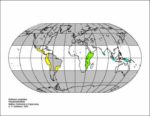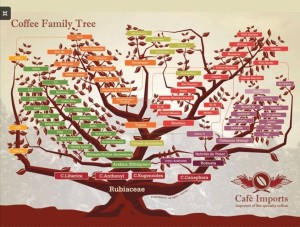Varieties & Origins 101 – An Introduction
The first step in becoming familiar with the world of coffee is to take a whirlwind tour of the “coffee belt” a geographic belt straddling the equator to about 30° North and South (or the Tropics of Cancer and Capricorn at 23.5° by some reckonings), at altitudes up to about 6,500 ft. Coffee just doesn’t grow well outside that belt. Then, there are other geographical considerations (altitude, climate) and cultural/historical ones as well. Once those are factored in, the coffee regions providing most specialty arabica coffee today are highlighted below:
- Yellow = Central and South America
- Green = East Africa and Yemen
- Turquoise = India and East Asia
- Straddling the belt = Islands (Hawaii, Jamaica, Papua New Guinea, Dominican Republic)
So, why then does coffee from each of these areas taste so different?
About 90%, IMHO, is due to three factors: cultivar and varietal, terroir, and processing methods.
Due to ‘cross-pollinating’ of coffee growing ideas these days, however, it’s becoming more common to see farmers experiment with different varietals and processing in their specific locations. It’s all very exciting for those who enjoy really interesting and different coffees, but it also requires us to understand what each variable contributes to what ends up in our cups. To learn more about these variables and what they mean, follow the links after each section below.
Meanwhile, if you would like to delve into the traditional distinctive profiles of each major coffee region, start with our summaries here.
Cultivars & Varietals
Cultivar and variety imparts distinctive characteristics to coffee that provide the raw materials–the “nature” to the processing method and terroir’s “nurture”. All specialty coffee comes from one species thought to have originated in Ethiopia, coffea arabica, and which has two cultivars, Typica and Bourbon. Dutch traders and French missionaries first carried them from the Near East (Ethiopia and Reunion Island near Madagascar) to all the other places they now grow. As a very general guide, Typica and its hybrid varietals seem to be favored in Indonesia, while Bourbon and its offspring are favored in the rest of the coffee-growing world. Of course, you will know of an exception that disproves the rule because growers are trying new things all the time, including introducing old varieties into new settings. Growers have crossed these with each other, with other non-arabica species (like robusta), and with natural mutations of the two cultivars. These experiments have created a wide spectrum of varietals with tastes, growth characteristics, fruit production volume and disease resistance, much like wine grape varieties have been developed. Varieties gaining attention recently for their attractive qualities in the final cup include Gesha, Pacamara, and Caturra, to name a few. We found this lovely chart from Cafe Imports showing the coffee family tree that might help keep it straight 😉
Dig deeper : Coffee Cultivars and Varietals
Terroir
Coffee aficionados stop short of classifying coffees by the cultivar or even the variety (except in the case of Gesha, perhaps) because the same varietal can taste very different when grown in different locations, or “origins” in coffee-speak. The local climates, soil composition, nutrients, what is planted next to the coffee tree, geography and altitude–the things winegrowers call terroir–have a major impact on the taste characteristics of the beans. For example, the Chikmagalur region of Southern India produces a fairly mild arabica coffee, but it can sometimes pick up a peppery, spicy flavor from pepper and spice trees that grow adjacent to and shade the coffee plants. Perhaps then, it is the combination of innate bean characteristics and the local contexts in which they are grown that provide the greatest impact on the final product. However, the combination of cultivar/varietal and terroir still do not tell the whole story. What happens after the beans are grown and harvested provides the rest of the picture.
Dig deeper: Coffee “Terroir” (Geography)
Processing & handling
Traditional processing methods also impact flavor profiles and mouth feel, so that a Bourbon grown at high altitude in Rwanda and prepared using traditional African “washed” methods tastes very different from a Bourbon grown at a lower altitude in Brazil and naturally processed. Much of the appeal of Sumatra coffees comes from the complexity that comes from the semi-washed (wet hulled) Giling Basah processing method commonly used. In that method, the coffee’s outer pulp is removed, and the beans are dried in the open, sometimes on patios or tarps on the ground, allowing for all manner of interesting flavors to attach to the beans, providing a less clean, more complex cup. By contrast, the washed coffees of Kenya and East Africa, where great effort is spent in protecting the drying beans from tainting, have pristine clean, sparkling profiles with extremely well-defined flavors.
Handling Far too many lots of coffees that could qualify as specialty grade coffee are ruined by poor handling between the farm and the consumer. Our importer partners insist on proper handling to preserve quality and then cup the coffee again once it arrives to ensure that the quality is maintained. We then re-test each batch before it goes to you. When it’s in your hands, extra attention to good brewing technique can make sure that all the inputs to your very special coffee pay off where it counts–in the cup. Read up on brewing tips here.
Dig deeper: Processing and Handling Methods
For even more information about coffee…
For those interested in reading about the very interesting, often sad, history of coffee and how it was carried to and established in its current regions, I recommend the excellent “Uncommon Grounds: The History of Coffee and How it Transformed Our World”, by Mark Pendergrast (2010).



